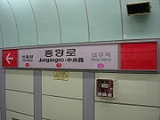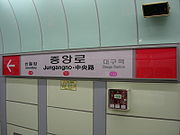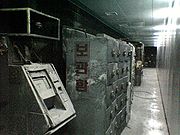
Daegu subway fire
Encyclopedia

Mass murder
Mass murder is the act of murdering a large number of people , typically at the same time or over a relatively short period of time. According to the FBI, mass murder is defined as four or more murders occurring during a particular event with no cooling-off period between the murders...
suicide attack
Suicide attack
A suicide attack is a type of attack in which the attacker expects or intends to die in the process.- Historical :...
on February 18, 2003 which killed at least 198 Koreans and injured at least 147. An arson
Arson
Arson is the crime of intentionally or maliciously setting fire to structures or wildland areas. It may be distinguished from other causes such as spontaneous combustion and natural wildfires...
ist set fire to a train
Train
A train is a connected series of vehicles for rail transport that move along a track to transport cargo or passengers from one place to another place. The track usually consists of two rails, but might also be a monorail or maglev guideway.Propulsion for the train is provided by a separate...
stopped at the Jungangno Station
Jungangno Station
Jungangno Station is a station of Daegu Subway Line 1 in Jung-gu, Daegu, South Korea.The neighborhood is lined with a large bookstore, a theater, a bank etc.A platform is narrow compared with a lot of floating population around the station.- Fire :...
of the Daegu Metropolitan Subway
Daegu Metropolitan Subway
-Lines:-Line 1:Line 1 was the site of the Daegu subway fire of 2003, when an arsonist set fire to a train in rush hour and killed nearly 200 people.-AGT Line:The transport department has approved plans to build an Automated Guideway Transit line.-Fare:...
in Daegu
Daegu
Daegu , also known as Taegu, and officially the Daegu Metropolitan City, is a city in South Korea, the fourth largest after Seoul, Busan, and Incheon, and the third largest metropolitan area in the country with over 2.5 million residents. The city is the capital and principal city of the...
, South Korea
South Korea
The Republic of Korea , , is a sovereign state in East Asia, located on the southern portion of the Korean Peninsula. It is neighbored by the People's Republic of China to the west, Japan to the east, North Korea to the north, and the East China Sea and Republic of China to the south...
. The fire then spread to a second train which had entered the station from the opposite direction a few minutes later.
Kim Dae-han
The arsonist was Kim Dae-han, a 56 year-old unemployed former taxiTaxicab
A taxicab, also taxi or cab, is a type of vehicle for hire with a driver, used by a single passenger or small group of passengers, often for a non-shared ride. A taxicab conveys passengers between locations of their choice...
driver who had suffered a stroke
Stroke
A stroke, previously known medically as a cerebrovascular accident , is the rapidly developing loss of brain function due to disturbance in the blood supply to the brain. This can be due to ischemia caused by blockage , or a hemorrhage...
in November 2001 that left him partly paralyzed. Kim was dissatisfied with his medical treatment and had expressed sentiments of violence
Violence
Violence is the use of physical force to apply a state to others contrary to their wishes. violence, while often a stand-alone issue, is often the culmination of other kinds of conflict, e.g...
and depression
Depression (mood)
Depression is a state of low mood and aversion to activity that can affect a person's thoughts, behaviour, feelings and physical well-being. Depressed people may feel sad, anxious, empty, hopeless, helpless, worthless, guilty, irritable, or restless...
; he later told police
Police
The police is a personification of the state designated to put in practice the enforced law, protect property and reduce civil disorder in civilian matters. Their powers include the legitimized use of force...
he wanted to kill himself
Suicide in South Korea
Suicide in South Korea occurs at the highest suicide rate among the 30 OECD countries, having recently surpassed Japan's rate. The toll of suicide deaths in South Korea has doubled in the last decade....
, but to do so in a crowded place rather than alone. By most accounts, on the morning of February 18, he boarded train 1079 on Line 1 in the direction of Daegok, carrying a duffel bag
Duffel bag
A duffel bag is a large cylindrical bag made of cloth with a drawstring closure at the top....
which contained two green milk
Milk
Milk is a white liquid produced by the mammary glands of mammals. It is the primary source of nutrition for young mammals before they are able to digest other types of food. Early-lactation milk contains colostrum, which carries the mother's antibodies to the baby and can reduce the risk of many...
cartons filled with a flammable liquid
Fire accelerant
In fire protection, an accelerant is any substance or mixture that "accelerates" the development of fire. Accelerants are often used to commit arson, and some accelerants may cause an explosion...
, possibly paint thinner
Paint thinner
A paint thinner is a solvent used to thin oil-based paints or clean up after their use, although all such solvents have other uses. Commercially, "paint thinner" is usually a name for mineral spirits.Products used as paint thinners include:*Mineral spirits...
or gasoline
Gasoline
Gasoline , or petrol , is a toxic, translucent, petroleum-derived liquid that is primarily used as a fuel in internal combustion engines. It consists mostly of organic compounds obtained by the fractional distillation of petroleum, enhanced with a variety of additives. Some gasolines also contain...
.
Arson
As the train left Daegu Station around 9:53 a.m., Kim began fumbling with the cartons and a cigaretteSmoking in South Korea
Smoking in South Korea is the leading cause of death in the country, with more than 40,000 people dying every year from smoking-related diseases. Koreans commonly smoke in restaurants and bars, nightclubs, noraebang, offices, Internet cafes and even some private hospitals. Posted signage...
lighter, alarming other passengers who tried to stop him. In the struggle, one of the cartons spilled and its liquid contents caught fire as the train pulled into Jungangno Station in downtown Daegu. Kim, his back and legs on fire, managed to escape along with many passengers on train 1079, but within two minutes the fire had spread to all six cars. The fire spread quickly in the insulation between the layers of aluminum that form the shell of the cars, the vinyl and plastic materials in seat cushions and strap handles, and heavy plastic matting on the floors, producing thick smoke as it burned.
The operator of the train, Choi Jeong-hwan (aged 31), failed to notify subway officials immediately of the fire.
Errors compound the disaster

Closed-circuit television
Closed-circuit television is the use of video cameras to transmit a signal to a specific place, on a limited set of monitors....
monitors, subway officials radioed the operator of train 1080, Choi Sang-yeol, advising him to proceed with caution because there was a fire in the station. Train 1080 entered Jungangno station and stopped alongside blazing train 1079 approximately four minutes later. The doors opened only briefly, then shut, apparently in an effort to keep out the toxic smoke that had filled the station. Shortly after train 1080's arrival, an automatic fire detector shut down the power supply to both trains, preventing train 1080 from leaving the station.
Transcripts show Choi Sang-yeol made three announcements advising passengers in train 1080 to remain seated while he attempted to reach superiors. Finally, he was advised "Quickly, run somewhere else. Go up... kill the engine and go." Choi then opened the doors and fled, but in doing so he removed the master key, shutting down the onboard batteries which powered the train doors — effectively sealing passengers inside. Later investigation showed 79 passengers remained trapped inside train 1080 and died there.
Inadequate emergency equipment also worsened the disaster. Daegu subway trains were not equipped with fire extinguisher
Fire extinguisher
A fire extinguisher or extinguisher, flame entinguisher is an active fire protection device used to extinguish or control small fires, often in emergency situations...
s, and the stations lacked sprinklers and emergency lighting. Many victims became disoriented in the dark, smoke-filled underground station and died of asphyxiation looking for exits. Emergency ventilation systems also proved inadequate. Over 1,300 fire and emergency personnel responded and the fire itself was extinguished around 1:25 p.m.; however, the toxicity of the smoke prevented them from entering the station for another three and a half hours.
Victims
The intensity of the fire made it difficult to accurately assess the number of victims. Most were burned beyond recognition, many to the bone, and required DNA analysis to identify. A total of 191 bodies were found and identified; 6 additional bodies were found but so thoroughly destroyed that they could not be identified; one person's possessions were identified but remains could not be located.As the incident occurred late in the morning rush hour
Rush hour
A rush hour or peak hour is a part of the day during which traffic congestion on roads and crowding on public transport is at its highest. Normally, this happens twice a day—once in the morning and once in the evening, the times during when the most people commute...
, most of the victims were students or young women who worked in the downtown district's department store
Department store
A department store is a retail establishment which satisfies a wide range of the consumer's personal and residential durable goods product needs; and at the same time offering the consumer a choice of multiple merchandise lines, at variable price points, in all product categories...
s, which opened at 10:30 a.m. Many were able to contact loved ones on their mobile phone
Mobile phone
A mobile phone is a device which can make and receive telephone calls over a radio link whilst moving around a wide geographic area. It does so by connecting to a cellular network provided by a mobile network operator...
s, and mobile phone operators released call connection and attempt records to help authorities determine who was in the station.
Investigation and coverup
Choi Sang-yeol could not be located for 10 hours after the accident, and investigators later discovered he had made contact with officials from the subway corporation during that time. The master key from train 1080 was found in an office at the Ansim train depot. Omissions from transcripts of radio communications also heightened suspicion of an attempted coverup.On February 26, 2003, authorities arrested Kim Dae-han, who had fled to a hospital for treatment. They also arrested both Choi and six officials of the Daegu Metropolitan Subway Corporation, the head of which was fired the same day.
Aftermath
The tragedy prompted outpourings of sympathy and anger from throughout South Korea and internationally.Officials promised to install better safety equipment in subway stations, and added spray-on fire resistant chemicals to the interiors of the cars of the Daegu Metropolitan Subway. Six stations were taken out of service for refurbishment and restored in April 2003. The tragedy was considered by many a national embarrassment, provoking debate about whether South Korea had cut too many corners in safety during its rapid industrialization. Several metro trains throughout the country were subsequently refurbished to improve fire-resistant standards within a few years of the accident.
On August 7, the Daegu District Court convicted Choi Sang-yeol, operator of train 1080, and Choi Jeong-hwan, operator of train 1079, sentencing them to prison for five and four years respectively for criminal negligence. Kim Dae-han was convicted of arson
Arson
Arson is the crime of intentionally or maliciously setting fire to structures or wildland areas. It may be distinguished from other causes such as spontaneous combustion and natural wildfires...
and homicide
Homicide
Homicide refers to the act of a human killing another human. Murder, for example, is a type of homicide. It can also describe a person who has committed such an act, though this use is rare in modern English...
. Although prosecutors and victims' families had asked for the death penalty, the court sentenced him to life in prison on account of his remorse and mental instability. Kim died in prison on August 31, 2004, in the city of Jinju
Jinju
Jinju is a city in South Gyeongsang Province, South Korea. It was the location of the first and second Sieges of Jinju by Japanese forces during the Imjin War...
, where he had been receiving medical treatment.
See also
- 2008 Namdaemun fire2008 Namdaemun fireThe 2008 Namdaemun fire was a fire set by Korean citizen and arsonist Chae Jong-gi that occurred on the Namdaemun, one of the most historically significant gates in Seoul, South Korea, and the first of Korea's National Treasures, on the date of February 10, 2008. The fire caused severe damage to...
- Suicide in South KoreaSuicide in South KoreaSuicide in South Korea occurs at the highest suicide rate among the 30 OECD countries, having recently surpassed Japan's rate. The toll of suicide deaths in South Korea has doubled in the last decade....
- King's Cross FireKing's Cross fireThe King's Cross St. Pancras tube station fire was a fatal fire on the London Underground. It broke out at approximately 19:30 on 18 November 1987, and killed 31 people....
- 7 July 2005 London bombings7 July 2005 London bombingsThe 7 July 2005 London bombings were a series of co-ordinated suicide attacks in the United Kingdom, targeting civilians using London's public transport system during the morning rush hour....
- 2004 Madrid train bombings
- 1995 Paris Metro bombing
- 2009 Chengdu bus fire2009 Chengdu bus fireThe 2009 Chengdu bus fire was a mass murder suicide attack on a bus that occurred in Chengdu, China on June 5, 2009. It resulted in 27 deaths, and 76 injuries. The arsonist was an unemployed man in his sixties named Zhang Yunliang , native of Suzhou, Jiangsu, who was also killed in the fire...
External links
- iCivilEngineer Engineering Failure Watch: South Korean Subway Fire
- Soo-Jeong. "Subway horror: Errors revealed," Associated PressAssociated PressThe Associated Press is an American news agency. The AP is a cooperative owned by its contributing newspapers, radio and television stations in the United States, which both contribute stories to the AP and use material written by its staff journalists...
. - Hwang Sun-yoon. "200 dead, missing in Daegu arson," Joong-Ang Ilbo, February 19, 2003
- Byun Duk-kun. "Slow Response Causes More Death," Hankook IlboHankook IlboHankook Ilbo is a vernacular daily newspaper published in Seoul, South Korea. It is a sister paper of The Korea Times. "Hankook" means "Korea" in Korean....
February 18, 2003 - Dozens Dead, Hundreds Injured, Missing in South Korea Subway Fire, CNNCNNCable News Network is a U.S. cable news channel founded in 1980 by Ted Turner. Upon its launch, CNN was the first channel to provide 24-hour television news coverage, and the first all-news television channel in the United States...
Transcript, February 18, 2003 - Anger mounts over Korean fire, BBCBBCThe British Broadcasting Corporation is a British public service broadcaster. Its headquarters is at Broadcasting House in the City of Westminster, London. It is the largest broadcaster in the world, with about 23,000 staff...
News, February 20, 2003 - Kirk, Don. "Effort to Fix Responsibility for Deadly Korean Subway Fire," New York Times, February 21, 2003
- "Fire Alarm Ignored and Not Immediately Informed," Dong-A IlboDong-a IlboThe Dong-a Ilbo is one of three major South Korean newspapers with over 2 million daily circulation...
, February 23, 2003 - Christensen, Geir. Letter to the Editor: "The Daegu Subway Fire," February 25, 2003
- "Death Toll in Daegu Is Likely to Reach 200," Dong-A Ilbo, February 26, 2003
- "Subway official told driver of train to leave passengers," Joong-Ang Ilbo, February 26, 2003
- Choi Jie-ho. "Safety first -- and 2d, 3d, 4th . . .," Joong-Ang Ilbo, April 8, 2003
- "Arsonist to serve life in Daegu subway fire, Joong-Ang IlboJoongAng IlboJoongAng Ilbo is a conservative newspaper published in Seoul, South Korea. It is one of the "big three newspapers" in South Korea. It has a circulation of 1.96 million copies in South Korea . Its average page count per copy is around 52...
, August 7, 2003 - Daegu Subway Fire photo slideshow

